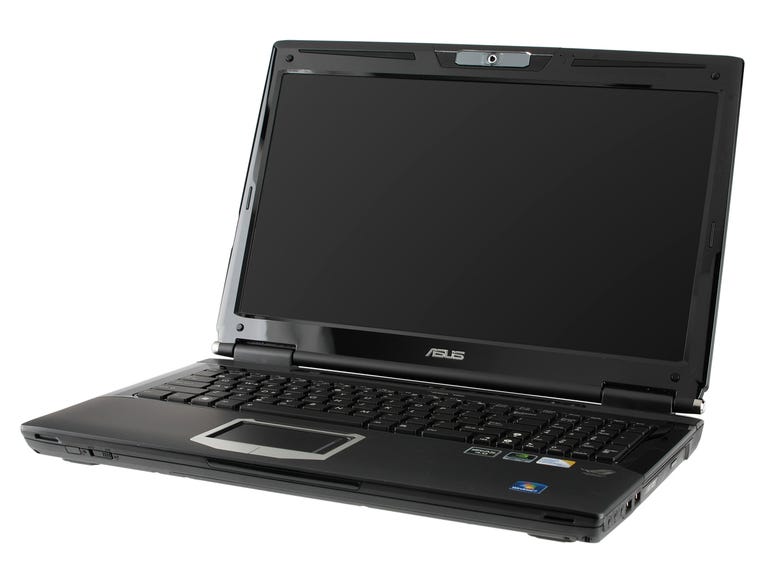Editors' note: This review is part of our 2009 Retail Laptop and Desktop Holiday Roundup, which covers specific fixed configurations of popular systems found in retail stores.
The Good
The Bad
The Bottom Line
Even when it comes to higher-end retail laptops, getting under the psychological $1,000 price barrier seems to be a chief priority of both laptop manufacturers and shoppers. It's no coincidence that this year's holiday retail roundup features two $999 high-end machines, this Asus G60VX and the Sony Vaio FW560F/T. The value in each is compelling: both feature better-than-average Core 2 Duo processors, but the Vaio leans towards being a portable home theater, with its Blu-ray drive and larger hard drive, while the Asus G60VX-RBBX05 favors gaming, dropping the Blu-ray drive, but adding a much more robust graphics card (an Nvidia GeForce GTX 260M) and a smaller-capacity but faster-rpm 320GB hard drive.
As part of Asus' high-end Republic of Gamers line of laptops, the G60VX-RBBX05 looks the part, but cuts out some features in order to make the price point. It falls between the G51 and G71 models in Asus' lineup, offering a screen size in the middle and a set of features that are at the lower end of the range available on Asus' Web site. In fact, it's pretty similar to the G71-RX05, which we reviewed in our back-to-school retail roundup. Back then, the G71 cost $1,199 and had a feature set that was similar, although with a 17-inch screen.
Months later, the G60VX seems like a slightly less impressive deal, despite the price reduction. Not having a Core 2 Quad or Core i7 processor, as many of the most serious gaming laptops now do, is a bit of a strike against it, and while other G60VX models have a 1080p-resolution screen, the G60VX-RBBX05 has a 1,366x768-pixel resolution. Still, for the price, this laptop can achieve some impressive mobile gaming performance if you can live without the bells and whistles.
| Price as reviewed | $999 |
| Processor | 2.1GHz Intel Core 2 Duo P7450 |
| Memory | 4GB, DDR2 800MHz |
| Hard drive | 320GB 7,200rpm |
| Chipset | Mobile Intel GM45 Express |
| Graphics | Nvidia GeForce GTX 260M, 1GB |
| Operating System | Windows 7 Home Premium (64-bit) |
| Dimensions (WD) | 14.8 x 10.4 inches |
| Height | 1.6 inches |
| Screen size (diagonal) | 16 inches |
| System weight / Weight with AC adapter | 7.3 / 8.8 pounds |
| Category | Desktop replacement |
As far as looks go, we prefer the chic minimalism of the Sony Vaio FW line to the Asus' chunkier, race-car-inspired chassis on the G60VX, but gamers who aspire to an Alienware type of design might find it satisfying. Clad in a glossy midnight blue exterior with minimal checkered pattern flourishes, the look is still pretty understated. Inside, a matte black, smooth palm-rest area and black, glossy plastic surround a large keyboard and the 16-inch screen.
Unlike the Sony Vaio FW560F/T, this Asus G60VX has a full raised keyboard and an adjacent number pad, making it much more effective for gaming. Also, the keyboard is backlit, a rarity in a sub-$1,000 laptop. Above the keyboard, a simple set of dedicated touch keys activate screen brightness and power usage modes. Next to the power button is an additional quick-launch button for launching Asus' Express Gate Splashtop OS, which offers Web browsing, e-mail, photo viewing, and Skype apps without going through a full Windows 7 boot-up (although, to be honest, we didn't find ourselves using this much). The keyboard's keys had a good feel, although it flexed a bit under our fingers. Meanwhile, the multitouch touch pad's surface and flush buttons were effective but unremarkable.
One of the G60VX-RBBX05's big feature claims is an EAX Advanced HD 4.0 audio system, with four speakers. We did hear 3D-style audio effects while playing games and listening to movies, and the faux-surround experience was one of the better we've heard. The audio definitely ranks as considerably above average--better at separation than at volume.
The glossy 16x9 16-inch LED screen on the Asus G60VX has a native resolution of 1,366x768 pixels, which is standard for midrange mainstream screens, but it's a dip down from the 1,600x900 pixels available on the Sony Vaio FW560F/T, and is not full HD, which is an option on some more expensive G60 models. While its size is still a nice balance between a 15-inch and a much larger laptop, we'd have preferred a higher resolution setting. Still, 720p is more than enough for nearly all of your multimedia and gaming needs.
| Asus G60VX-RBBX05 | Average for category [desktop replacement] | |
| Video | VGA-out, HDMI | VGA and HDMI or DisplayPort |
| Audio | Stereo speakers, headphone/microphone jacks, S/PDIF jack | Stereo speakers with subwoofer, headphone/microphone jacks. |
| Data | 4 USB 2.0, SD card reader, mini-Firewire, eSATA | 4 USB 2.0, SD card reader |
| Expansion | None | ExpressCard/54 |
| Networking | Ethernet, 802.11 b/g/n Wi-Fi | Ethernet, 802.11 b/g/n Wi-Fi, Bluetooth |
| Optical drive | DVD burner | DVD burner [high-end: Blu-ray] |
On the one hand, the Asus G60VX-RBBX05's selection of ports is generous, offering both mini-Firewire and eSATA, as well as four USB 2.0 ports to create a wide assortment of connection options. On the other hand, this Asus inexplicably lacks Bluetooth. It's odd simply because there are a great number of Bluetooth gaming peripherals, and to include this feature would seem like a no-brainer. One nice aspect of the G60VX-RBBX05's design is its spreading of some of the port placements to the back (one USB, Ethernet, and the power jack). While VGA or HDMI would also have made sense, it's nice to spread out the connections instead of bunching them on one side.
Compared with the similarly priced Sony Vaio FW560F/T, the G60VX-RBBX05 has both less RAM (4GB vs 6GB) and a smaller hard drive (320 vs 500GB), but in the case of the hard drive, this Asus has a platter running at a faster 7200rpm, which is an advantage for gaming. It's a shame this model didn't throw in more RAM.
The Asus G60VX-RBXX05 has the exact same Intel Core 2 Duo processor as the Sony Vaio FW560F/T: a 2.1 GHz P7450, which is a better-than-average processor, but it's still not as powerful as a Core i7. In multitasking tests, the Asus G60VX was a far cry from the Core i7 performance in an HP Envy 15 or HP Pavilion dv7-3085dx.
There is a slight overclocking feature offered as one of Asus' power settings, but it won't turn your laptop into a different machine. More impressive, and worth noting, is its high-end GeForce GTX 260M GPU, which gave us very strong frame rates and great gaming performance in our Unreal Tournament III test (116.4fps in 1,280x720 pixels). In fact, at that resolution setting, the Asus G60VX-RBBX05 bested our other retail high-end laptops this season, and earned its reputation as a serious gaming laptop. For this reason alone, the Asus G60VX-RBBX05 should be a consideration for a gamer on a (relative) budget.
| Asus G60VX-RBBX05 | Avg watts/hour |
| Off (60%) | 0.73 |
| Sleep (10%) | 1.43 |
| Idle (25%) | 30.87 |
| Load (05%) | 64.29 |
| Raw kWh Number | 130.13 |
| Annual Energy Cost | $14.77 |
Now for the heartbreak: you'd better keep this laptop plugged in. The Asus G60VX-RBBX05's six-cell battery lasted only 1 hour and 37 minutes in our video playback battery drain test, which places it dead last in that category. The Sony Vaio FW560F/T's battery life approached twice as long.
Asus includes a two-year, parts-and-labor warranty with the system; however, the battery is only covered for one year. The company's support Web site has improved much over the past few years (but is still a bit confusing), and includes driver downloads and manuals, along with a brief FAQ section. Retail stores offer a variety of extended warranty plans with your laptop purchase, but they're generally expensive and hard to use, so we do not recommend them.
(Shorter bars indicate better performance)
(Shorter bars indicate better performance)
(Shorter bars indicate better performance)
(Longer bars indicate better performance)
| 1280x800, 0X AA, 8X AF* | 1440x900, 4X AA, 8X AF* |
(Longer bars indicate better performance)
System configurations:
Asus G60VX-RBBX05
Windows 7 Home Premium (64-bit); 2.13GHz Intel Core 2 Duo P7450; 4096MB DDR2 SDRAM 800MHz;
1GB Nvidia GeForce GTX 260M; 320GB Seagate 7,200rpm
HP Envy 15-1050dx
Windows 7 Home Premium (64-bit); 1.6GHz Intel Core i7 720QM; 6144MB DDR3 SDRAM 1066MHz;
1GB ATI Mobility Radeon HD 4830; 500GB Seagate 7,200rpm
Sony Vaio VGN-FW560F/T
Windows 7 Home Premium (64-bit); 2.13GHz Intel Core 2 Duo P7450; 6144MB DDR2 SDRAM 800MHz;
512MB ATI Mobility Radeon HD 4650; 500GB Hitachi 5,400rpm
HP Pavilion dv7-3085dx
Windows 7 Home Premium (64-bit); 1.6GHz Intel Core i7 720QM; 6144MB DDR3 SDRAM 1066MHz;
1GB Nvidia GeForce GT 230M; 500GB Seagate 7,200rpm



